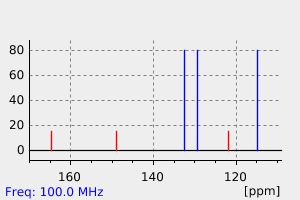四唑并[1,5-a]吡啶-6-羧酸 | 7477-13-6
中文名称
四唑并[1,5-a]吡啶-6-羧酸
中文别名
四唑并[1,5-A]吡啶-6-羧酸
英文名称
tetrazolo[1,5-a]pyridine-6-carboxylic acid
英文别名
——
CAS
7477-13-6
化学式
C6H4N4O2
mdl
MFCD09971234
分子量
164.123
InChiKey
WIUSYICWELGOHK-UHFFFAOYSA-N
BEILSTEIN
——
EINECS
——
-
物化性质
-
计算性质
-
ADMET
-
安全信息
-
SDS
-
制备方法与用途
-
上下游信息
-
文献信息
-
表征谱图
-
同类化合物
-
相关功能分类
-
相关结构分类
物化性质
-
密度:1.79±0.1 g/cm3(Predicted)
计算性质
-
辛醇/水分配系数(LogP):-0.2
-
重原子数:12
-
可旋转键数:1
-
环数:2.0
-
sp3杂化的碳原子比例:0.0
-
拓扑面积:80.4
-
氢给体数:1
-
氢受体数:5
安全信息
-
危险等级:IRRITANT
-
危险品标志:Xi
-
海关编码:2933990090
-
WGK Germany:3
-
包装等级:III
-
危险类别:6.1
-
危险性防范说明:P261,P264,P270,P271,P280,P301+P310+P330,P302+P352,P304+P340+P312,P305+P351+P338,P332+P313,P337+P313,P403+P233,P405,P501
-
危险品运输编号:2811
-
危险性描述:H301,H315,H319,H335
SDS
模块 1. 化学品
1.1 产品标识符
: Tetrazolo[1,5-a]pyridine-6-carboxylic acid
产品名称
1.2 鉴别的其他方法
无数据资料
1.3 有关的确定了的物质或混合物的用途和建议不适合的用途
仅用于研发。不作为药品、家庭或其它用途。
模块 2. 危险性概述
2.1 GHS-分类
急性毒性, 经口 (类别 4)
眼睛刺激 (类别 2A)
2.2 GHS 标记要素,包括预防性的陈述
象形图
警示词 警告
危险申明
H302 吞咽有害。
H319 造成严重眼刺激。
警告申明
预防措施
P264 操作后彻底清洁皮肤。
P270 使用本产品时不要进食、饮水或吸烟。
P280 戴护目镜/戴面罩。
事故响应
P301 + P312 如果吞咽并觉不适: 立即呼叫解毒中心或就医。
P305 + P351 + P338 如与眼睛接触,用水缓慢温和地冲洗几分钟。如戴隐形眼镜并可方便地取
出,取出隐形眼镜,然后继续冲洗.
P330 漱口。
P337 + P313 如仍觉眼睛刺激:求医/就诊。
废弃处置
P501 将内容物/ 容器处理到得到批准的废物处理厂。
2.3 其它危害物 - 无
模块 3. 成分/组成信息
3.1 物 质
: C6H4N4O2
分子式
: 164.12 g/mol
分子量
组分 浓度或浓度范围
Tetrazolo[1,5-a]pyridine-6-carboxylic acid
-
化学文摘登记号(CAS 7477-13-6
No.)
模块 4. 急救措施
4.1 必要的急救措施描述
一般的建议
请教医生。 向到现场的医生出示此安全技术说明书。
吸入
如果吸入,请将患者移到新鲜空气处。 如呼吸停止,进行人工呼吸。 请教医生。
皮肤接触
用肥皂和大量的水冲洗。 请教医生。
眼睛接触
用大量水彻底冲洗至少15分钟并请教医生。
食入
切勿给失去知觉者通过口喂任何东西。 用水漱口。 请教医生。
4.2 主要症状和影响,急性和迟发效应
据我们所知,此化学,物理和毒性性质尚未经完整的研究。
4.3 及时的医疗处理和所需的特殊处理的说明和指示
无数据资料
模块 5. 消防措施
5.1 灭火介质
灭火方法及灭火剂
用水雾,抗乙醇泡沫,干粉或二氧化碳灭火。
5.2 源于此物质或混合物的特别的危害
碳氧化物, 氮氧化物
5.3 给消防员的建议
如必要的话,戴自给式呼吸器去救火。
5.4 进一步信息
无数据资料
模块 6. 泄露应急处理
6.1 作业人员防护措施、防护装备和应急处置程序
使用个人防护用品。 避免粉尘生成。 避免吸入蒸气、烟雾或气体。 保证充分的通风。 避免吸入粉尘。
6.2 环境保护措施
不要让产品进入下水道。
6.3 泄漏化学品的收容、清除方法及所使用的处置材料
收集和处置时不要产生粉尘。 扫掉和铲掉。 放入合适的封闭的容器中待处理。
6.4 参考其他部分
丢弃处理请参阅第13节。
模块 7. 操作处置与储存
7.1 安全操作的注意事项
避免接触皮肤和眼睛。 避免形成粉尘和气溶胶。
在有粉尘生成的地方,提供合适的排风设备。
7.2 安全储存的条件,包括任何不兼容性
贮存在阴凉处。 使容器保持密闭,储存在干燥通风处。
7.3 特定用途
无数据资料
模块 8. 接触控制和个体防护
8.1 容许浓度
最高容许浓度
没有已知的国家规定的暴露极限。
8.2 暴露控制
适当的技术控制
根据良好的工业卫生和安全规范进行操作。 休息前和工作结束时洗手。
个体防护设备
眼/面保护
带有防护边罩的安全眼镜符合 EN166要求请使用经官方标准如NIOSH (美国) 或 EN 166(欧盟)
检测与批准的设备防护眼部。
皮肤保护
戴手套取 手套在使用前必须受检查。
请使用合适的方法脱除手套(不要接触手套外部表面),避免任何皮肤部位接触此产品.
使用后请将被污染过的手套根据相关法律法规和有效的实验室规章程序谨慎处理. 请清洗并吹干双手
所选择的保护手套必须符合EU的89/686/EEC规定和从它衍生出来的EN 376标准。
身体保护
全套防化学试剂工作服, 防护设备的类型必须根据特定工作场所中的危险物的浓度和数量来选择。
呼吸系统防护
如须暴露于有害环境中,请使用P95型(美国)或P1型(欧盟 英国
143)防微粒呼吸器。如需更高级别防护,请使用OV/AG/P99型(美国)或ABEK-P2型 (欧盟 英国 143)
防毒罐。
呼吸器使用经过测试并通过政府标准如NIOSH(US)或CEN(EU)的呼吸器和零件。
模块 9. 理化特性
9.1 基本的理化特性的信息
a) 外观与性状
形状: 固体
b) 气味
无数据资料
c) 气味阈值
无数据资料
d) pH值
无数据资料
e) 熔点/凝固点
无数据资料
f) 沸点、初沸点和沸程
无数据资料
g) 闪点
无数据资料
h) 蒸发速率
无数据资料
i) 易燃性(固体,气体)
无数据资料
j) 高的/低的燃烧性或爆炸性限度 无数据资料
k) 蒸气压
无数据资料
l) 蒸汽密度
无数据资料
m) 密度/相对密度
无数据资料
n) 水溶性
无数据资料
o) n-辛醇/水分配系数
无数据资料
p) 自燃温度
无数据资料
q) 分解温度
无数据资料
r) 粘度
无数据资料
模块 10. 稳定性和反应活性
10.1 反应性
无数据资料
10.2 稳定性
无数据资料
10.3 危险反应
无数据资料
10.4 应避免的条件
无数据资料
10.5 不相容的物质
强氧化剂
10.6 危险的分解产物
模块 11. 毒理学资料
11.1 毒理学影响的信息
急性毒性
半数致死剂量 (LD50) 经口 - 大鼠 - 980 mg/kg
皮肤刺激或腐蚀
无数据资料
眼睛刺激或腐蚀
眼睛 - 兔子 - 中度的眼睛刺激
呼吸道或皮肤过敏
无数据资料
生殖细胞致突变性
无数据资料
致癌性
IARC:
此产品中没有大于或等于 0。1%含量的组分被 IARC鉴别为可能的或肯定的人类致癌物。
生殖毒性
无数据资料
特异性靶器官系统毒性(一次接触)
无数据资料
特异性靶器官系统毒性(反复接触)
无数据资料
吸入危险
无数据资料
潜在的健康影响
吸入 吸入可能有害。 可能引起呼吸道刺激。
摄入 误吞对人体有害。
皮肤 通过皮肤吸收可能有害。 可能引起皮肤刺激。
眼睛 造成严重眼刺激。
接触后的征兆和症状
据我们所知,此化学,物理和毒性性质尚未经完整的研究。
附加说明
化学物质毒性作用登记: 无数据资料
模块 12. 生态学资料
12.1 生态毒性
无数据资料
12.2 持久性和降解性
无数据资料
12.3 潜在的生物累积性
无数据资料
12.4 土壤中的迁移性
无数据资料
12.5 PBT 和 vPvB的结果评价
无数据资料
12.6 其它不良影响
无数据资料
模块 13. 废弃处置
13.1 废物处理方法
产品
将剩余的和不可回收的溶液交给有许可证的公司处理。
与易燃溶剂相溶或者相混合,在备有燃烧后处理和洗刷作用的化学焚化炉中燃烧
受污染的容器和包装
按未用产品处置。
模块 14. 运输信息
14.1 联合国危险货物编号
欧洲陆运危规: - 国际海运危规: - 国际空运危规: -
14.2 联合国运输名称
欧洲陆运危规: 非危险货物
国际海运危规: 非危险货物
国际空运危规: 非危险货物
14.3 运输危险类别
欧洲陆运危规: - 国际海运危规: - 国际空运危规: -
14.4 包裹组
欧洲陆运危规: - 国际海运危规: - 国际空运危规: -
14.5 环境危险
欧洲陆运危规: 否 国际海运危规 国际空运危规: 否
海洋污染物(是/否): 否
14.6 对使用者的特别提醒
无数据资料
模块 15 - 法规信息
N/A
模块16 - 其他信息
N/A
上下游信息
-
下游产品
中文名称 英文名称 CAS号 化学式 分子量 —— ethyl tetrazolo[1,5-a]pyridine-6-carboxylate 1224886-35-4 C8H8N4O2 192.177
反应信息
-
作为反应物:描述:四唑并[1,5-a]吡啶-6-羧酸 在 草酰氯 、 (5,10,15,20-tetraphenylporphyrinato)manganese(III) chloride 、 三乙胺 、 N,N-二甲基甲酰胺 、 锌 作用下, 以 二氯甲烷 、 苯 为溶剂, 反应 34.0h, 生成参考文献:名称:1,2,3,4-四唑的双重反应:锰催化的点击反应和脱氮环化反应。摘要:据报道,使用基于锰卟啉的催化系统的一般催化方法可实现两种不同的反应(点击反应和脱氮环化反应),并提供两种不同类型的氮杂环,即1,5-二取代的1,2,3-三唑(具有吡啶基)和1,2,4-三唑并吡啶。机理研究表明,尽管点击反应可能是通过离子机理进行的,这与传统的点击反应不同,但脱氮环化反应可能是通过亲电子的茂金属中间体而不是金属金属中间体进行的。总体而言,此方法非常高效,与其他方法相比,具有许多优点。例如,2副产品产生气体。DOI:10.1002/anie.202009078
-
作为产物:参考文献:名称:基于铁(II)的金属铁活化:从传统的点击化学转换为脱氮环化摘要:通过催化量的Fe(TPP)Cl和Zn粉尘发现了1,2,3,4-四唑和炔烃的分子间脱氮环化的独特概念。该反应排除了有机叠氮化物和炔烃之间传统的,更受欢迎的点击反应,而是通过空前的金属-金属活化来进行。预计该方法将促进重要的基本氮杂环的构建,而这反过来又可以发现新的候选药物。DOI:10.1002/anie.201904702
文献信息
-
PYRROLO[2,3-d]PYRIMIDINE TROPOMYSIN-RELATED KINASE INHIBITORS申请人:Andrews Mark David公开号:US20120258950A1公开(公告)日:2012-10-11The present invention relates to compounds of Formula (I) and their pharmaceutically acceptable salts, wherein the substituents are as described herein, and their use in medicine, in particular as Trk antagonists.本发明涉及式(I)化合物及其药学上可接受的盐,其中取代基如本文所述,并且它们在医学上的用途,特别是作为Trk拮抗剂。
-
[EN] NOVEL ANTIFUNGAL PYRIDINYLHYDRAZIDE DERIVATIVES<br/>[FR] NOUVEAUX DÉRIVÉS ANTIFONGIQUES DE PYRIDINYLHYDRAZIDE申请人:DAE WOONG PHARMA公开号:WO2015034271A1公开(公告)日:2015-03-12The present invention relates to novel pyridinylhydrazide derivatives and a method for manufacturing the same. The pyridinylhydrazide derivatives of the present invention have excellent antifungal and fungicidal activities, and thus will be useful for the prevention and treatment of various fungal infections. Additionally, the pyridinylhydrazide derivatives of the present invention, unlike other fungicidal preparations, can be orally administered.
-
TRPM8 ANTAGONISTS AND THEIR USE IN TREATMENTS申请人:Biswas Kaustav公开号:US20130157996A1公开(公告)日:2013-06-20Compounds of Formula I are useful as antagonists of TRPM8. Such compounds are useful in treating a number of TRPM8 mediated disorders and conditions and may be used to prepare medicaments and pharmaceutical compositions useful for treating such disorders and conditions. Examples of such disorders include, but are not limited to, migraines and neuropathic pain. Compounds of Formula I have the following structure: where the definitions of the variables are provided herein.公式I的化合物可用作TRPM8的拮抗剂。这些化合物在治疗许多TRPM8介导的疾病和病症方面非常有用,并可用于制备用于治疗此类疾病和病症的药物和制剂。此类疾病的示例包括但不限于偏头痛和神经病性疼痛。公式I的化合物具有以下结构:其中变量的定义在此提供。
-
Iron-Catalyzed Intermolecular Amination of Benzylic C(sp<sup>3</sup>)–H Bonds作者:Hillol Khatua、Subrata Das、Sima Patra、Sandip Kumar Das、Satyajit Roy、Buddhadeb ChattopadhyayDOI:10.1021/jacs.2c10719日期:2022.12.7intermolecular benzylic C(sp3)–H amination is developed utilizing 1,2,3,4-tetrazole as a nitrene precursor via iron catalysis. This method enables direct installation of 2-aminopyridine into the benzylic and heterobenzylic position. The method selectively aminates 2° benzylic C(sp3)–H bond over the 3° and 1° benzylic C(sp3)–H bonds. Experimental studies reveal that the C(sp3)–H amination undergoes via the formation
-
Iron-Catalyzed Intermolecular C–N Cross-Coupling Reactions via Radical Activation Mechanism作者:Subrata Das、Andreas W. Ehlers、Sima Patra、Bas de Bruin、Buddhadeb ChattopadhyayDOI:10.1021/jacs.3c05627日期:2023.7.12aromatic and aliphatic azides with boronic acids under iron-catalyzed conditions. The amination follows an unprecedented metalloradical activation mechanism that is different from traditional metal-catalyzed C–N cross-coupling reactions. The scope of the reaction has been demonstrated by the employment of a large number of tetrazoles, azides, and boronic acids. Moreover, several late-stage aminations
表征谱图
-
氢谱1HNMR
-
质谱MS
-
碳谱13CNMR
-
红外IR
-
拉曼Raman
-
峰位数据
-
峰位匹配
-
表征信息
同类化合物
(S)-氨氯地平-d4
(R,S)-可替宁N-氧化物-甲基-d3
(R)-(+)-2,2'',6,6''-四甲氧基-4,4''-双(二苯基膦基)-3,3''-联吡啶(1,5-环辛二烯)铑(I)四氟硼酸盐
(R)-N'-亚硝基尼古丁
(R)-DRF053二盐酸盐
(5E)-5-[(2,5-二甲基-1-吡啶-3-基-吡咯-3-基)亚甲基]-2-亚磺酰基-1,3-噻唑烷-4-酮
(5-溴-3-吡啶基)[4-(1-吡咯烷基)-1-哌啶基]甲酮
(5-氨基-6-氰基-7-甲基[1,2]噻唑并[4,5-b]吡啶-3-甲酰胺)
(2S,2'S)-(-)-[N,N'-双(2-吡啶基甲基]-2,2'-联吡咯烷双(乙腈)铁(II)六氟锑酸盐
(2S)-2-[[[9-丙-2-基-6-[(4-吡啶-2-基苯基)甲基氨基]嘌呤-2-基]氨基]丁-1-醇
(2R,2''R)-(+)-[N,N''-双(2-吡啶基甲基)]-2,2''-联吡咯烷四盐酸盐
(1'R,2'S)-尼古丁1,1'-Di-N-氧化物
黄色素-37
麦斯明-D4
麦司明
麝香吡啶
鲁非罗尼
鲁卡他胺
高氯酸N-甲基甲基吡啶正离子
高氯酸,吡啶
高奎宁酸
马来酸溴苯那敏
马来酸氯苯那敏-D6
马来酸左氨氯地平
顺式-双(异硫氰基)(2,2'-联吡啶基-4,4'-二羧基)(4,4'-二-壬基-2'-联吡啶基)钌(II)
顺式-二氯二(4-氯吡啶)铂
顺式-二(2,2'-联吡啶)二氯铬氯化物
顺式-1-(4-甲氧基苄基)-3-羟基-5-(3-吡啶)-2-吡咯烷酮
顺-双(2,2-二吡啶)二氯化钌(II) 水合物
顺-双(2,2'-二吡啶基)二氯化钌(II)二水合物
顺-二氯二(吡啶)铂(II)
顺-二(2,2'-联吡啶)二氯化钌(II)二水合物
韦德伊斯试剂
非那吡啶
非洛地平杂质C
非洛地平
非戈替尼
非布索坦杂质66
非尼拉朵
非尼拉敏
雷索替丁
阿雷地平
阿瑞洛莫
阿扎那韦中间体
阿培利司N-6
阿伐曲波帕杂质40
间硝苯地平
间-硝苯地平
镉,二碘四(4-甲基吡啶)-
锌,二溴二[4-吡啶羧硫代酸(2-吡啶基亚甲基)酰肼]-







